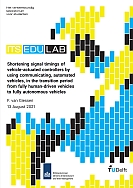Intersections are the bottleneck of traffic flow. Vehicle-actuated control improved the delay at an intersection by making the green phase variable based on the presence of vehicles as measured by detector loops. The duration of the yellow and red phase remains fixed, because intentions of specific human-driven vehicles (HDVs) are unknown, and measurements of the behaviour of HDVs at crucial moments can not be provided by detector loops. The introduction of connected autonomous vehicles (AVs) will bring a transition (hybrid) period, in which HDVs and AVs share the road. Intersection controllers for this period have been proposed, but none of them improve delay at low penetration rates. The AVs could be used to provide additional information at crucial moments. This report proposes a new controller for the complete range of penetration rates of AVs, in which the controller aims to shorten the yellow and red phase. The information of the AVs is used to identify the scenario at the intersection and apply control actions based on predictions. Simulations revealed that the yellow and red phase are shortened from low penetration rates (2%) onwards, but that the delay compared to the original controller only decreases after at penetration rates of 10% and higher.

|
Publication date:
August 27, 2021 Download report: MSc_Thesis_Femke_van_Giessen Research topic: Traffic management Research question: Cooperative and automated driving Project: Traffic signal control in the transition from manual to automated driving Related report: Energy efficient electric vehicle platooning at signalized intersections Design of an urban traffic controller that incorporates route advice given by in-vehicle navigation systems Analysis of current Dutch traffic management effectiveness with automated vehicles: a ramp-metering case study |